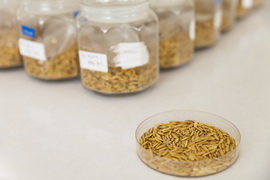
CRISPR-Cas9 and -Cpf1-mediated Editing of the Stomatal Development Gene in Rice
April 6, 2017| |
 The introduction and use of systems biology approaches have identified several genes involved in the early development of a plant. With this knowledge, a suitable tool is required for the functional validation of candidate genes. The development of the CRISPR-Cas9/Cpf1 system has provided a powerful tool for creating loss of function mutants for studying genes of interest.
The introduction and use of systems biology approaches have identified several genes involved in the early development of a plant. With this knowledge, a suitable tool is required for the functional validation of candidate genes. The development of the CRISPR-Cas9/Cpf1 system has provided a powerful tool for creating loss of function mutants for studying genes of interest.
Researchers from International Rice Research Institute in the Philippines, in cooperation with scientists from University of Sheffield in UK, University of North Carolina at Chapel Hill in the USA and the Universidad Nacional Autónoma de Mexico Cuernavaca in Mexico used both CRISPR-Cas9 and CRISPR-Cpf1 technology to knock out an early developmental gene OsEPFL9 (Epidermal Patterning Factor like-9), the rice ortholog of a positive regulator of stomatal development in Arabidopsis.
The mutants generated showed genome edits that were carried forward into the T2 generation and homozygous mutants were obtained. The homozygous mutant plants showed more than an 800% reduction in stomatal density on the abaxial leaf surface of the mutant rice plants. The analysis also showed no significant off-target effects.
The team also used the CRISPR-LbCpf1 (Lachnospiracae bacterium Cpf1) to target the same OsEPFL9 gene and found that Cpf1 is also capable of genome editing and edits get transmitted through generations with similar phenotypic changes seen with CRISPR-Cas9.
This study shows the effectiveness of CRISPR-Cas9 and Cpf1 in precisely targeting genomic locations and developing homozygous heritable gene edits. This system will be vital in gene function studies.
For more on this study, read the article in Plant Cell Reports.
| |
Biotech Updates is a weekly newsletter of ISAAA, a not-for-profit organization. It is distributed for free to over 22,000 subscribers worldwide to inform them about the key developments in biosciences, especially in biotechnology. Your support will help us in our mission to feed the world with knowledge. You can help by donating as little as $10.
-
See more articles:
-
News from Around the World
- Parliamentary Journalists Support Dialogue on the Biotech and Biosafety Bill Passage in Uganda
- Kenyan Youth Farmers Call for Adoption of WEMA Bt Maize
- Senegal Ready for GMOs, Says President Macky Sall
- Researchers Reveal Family Tree of Microorganisms Responsible for Photosynthesis
- Survey Reveals 90% of Rural Producers in Brazil Recognize Importance of Biotechnology
- Scientists Develop GE Rice that Flower on Demand
- Oxford University Starts Research on Marijuana
-
Research Highlights
- Chitinase Gene Confers Enhanced Resistance Against Rice Sheath Blight
- Gm1-MMP Enhances Tolerance to High Temperature and Humidity in Arabidopsis
-
Beyond Crop Biotech
- USDA Scientists Use Biotech Tools to Improve Guayule Plant As Natural Source of Tire Rubber
- Overexpression of AtSHN1 in Mulberry Reduces Postharvest Water Loss in Leaves
-
Resources
- The Petri Dish is Now Online
- Are GMOs Good or Bad? Genetic Engineering & Our Food
-
Plant
- Rapid Breeding of Parthenocarpic Tomato using CRISPR-Cas9
- CRISPR-Cas9 and -Cpf1-mediated Editing of the Stomatal Development Gene in Rice
-
Read the latest: - Biotech Updates (December 17, 2025)
- Gene Editing Supplement (December 17, 2025)
- Gene Drive Supplement (February 22, 2023)
-
Subscribe to BU: - Share
- Tweet
